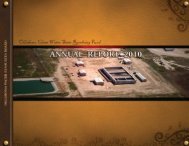kiamichi river basin water resources development plan
kiamichi river basin water resources development plan
kiamichi river basin water resources development plan
Create successful ePaper yourself
Turn your PDF publications into a flip-book with our unique Google optimized e-Paper software.
Kiamichi River Basin Water Resources Development PlanBACKGROUNDSardis Lake, on Jackfork Creek in southeast Oklahoma, was constructed by the U.S. ArmyCorps of Engineers between 1975 and 1982 primarily for <strong>water</strong> supply, flood control andrecreation, fish and wildlife purposes. Because the state had confidence that the lake’s <strong>water</strong>supply would be utilized by local users and/or as a supplemental regional source for centralOklahoma, the Oklahoma Water Storage Commission entered into the Sardis Reservoir StorageContract with the Corps.The Oklahoma Water Storage Commission was created by the Oklahoma Legislature in1963 to promote the maximum <strong>development</strong> of state <strong>water</strong> <strong>resources</strong>. The Commission,comprised of the seven (later nine) members of the Oklahoma Water Resources Board, wascharged with reviewing and determining the feasibility of proposed federal projects as well asthe present and anticipated needs of users in the projects’ <strong>water</strong>sheds. If such a determinationwas made, the Commission was directed to negotiate with the federal government,municipalities and other interests to repay the cost of conservation storage in the project. TheCommission had no authority to build projects, only power to underwrite construction. Onlystorage not estimated for present or future needs could be contracted for; the Commissionwould then hold this surplus <strong>water</strong> in trust until needed. At that time, the state would recover itsstorage costs from the new customer(s). The Water Storage Commission survived for 16 years,holding its first meeting in August 1963. Senate Bill 138, known as the "Oklahoma Sunset Law,"terminated the Water Conservation Storage Commission and transferred all existing obligationsto the OWRB. The Commission’s last meeting was held in June 1979.The Sardis Lake Water Storage Contract enables the state to use storage in the lake formunicipal and industrial <strong>water</strong> supply in return for repayment of the project’s construction costsattributed to <strong>water</strong> supply use. Forty-seven percent of the project’s <strong>water</strong> supply storage isreserved for “present use” while 53 percent is reserved for “future use” where the contract’sinterest (4.012 percent) accumulates until that storage is used. The 1974 contract estimated<strong>water</strong> supply construction costs to total $16.4 million. Through the Statewide WaterDevelopment Revolving Fund, which also serves as the funding source for Oklahomacommunities in need of <strong>water</strong> and sewer project improvements, the state initially made sixannual payments to the Corps for approximately $2.7 million. Sardis is the only <strong>water</strong> supplylake in Oklahoma for which the state holds a contract to repay storage costs.Anticipated <strong>development</strong> and subsequent use of Sardis Lake’s <strong>water</strong> supply has not beenrealized and because the contract states that the Oklahoma Legislature is not legally obligatedto appropriate funds for the payments, the State Legislature elected in 1989 not to authorizeadditional payments to the Corps. While payments were made in 1996 and 1997, bringing thepaid amount to $4.3 million, the state again deferred payments in 1998 and 1999. Oklahoma iscurrently $5.5 million in arrears, with the Corps claiming late payment interest of more than $2million; outstanding storage costs now amount to approximately $40 million. Annual paymentsfor use of Sardis <strong>water</strong> storage could reach as much as $2 million when both present and future<strong>water</strong> supply storage are utilized.Since 1990, several studies have been conducted and numerous efforts made to addressthe Sardis Reservoir contract/<strong>water</strong> use controversy. Progressively, each has resulted in betterunderstanding of issues pertinent to the matter. However, further uncertainties presentedthrough two lawsuits filed in 1998 prompted additional review of the situation.Responding to local concerns, the Board adopted a permanent rule in July 1999 that setaside 20,000 ac-ft/yr for future <strong>water</strong> use in the 10-county area incorporating the Kiamichi RiverBasin. As the OWRB continues working to fulfill its mandate under HCR 1066, the agency iscooperating with the Corps of Engineers and the Office of Management and Budget to negotiatedetails of a potential discounted purchase of the Sardis <strong>water</strong> supply storage, estimated atapproximately $20 million or less. In addition, Section 545 of the Water Resources Development5


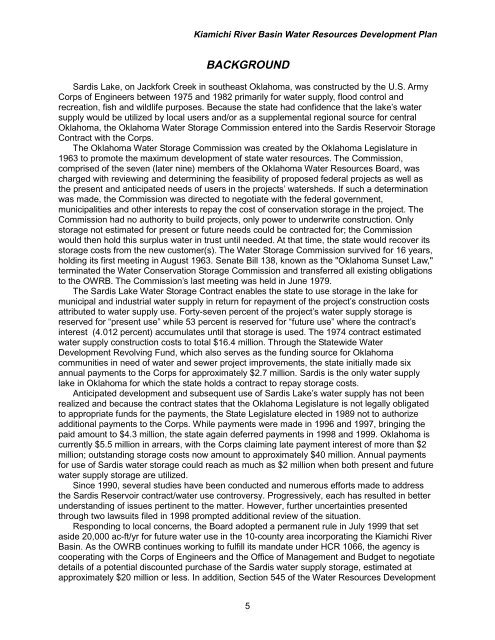

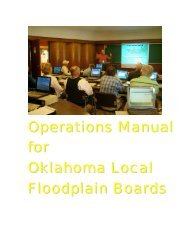
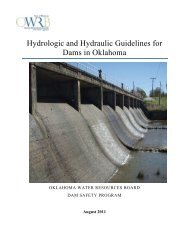
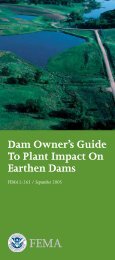

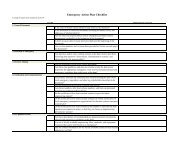


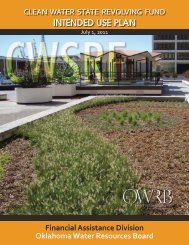


![A Commodity & a Resource [pdf] - Water Resources Board - State of ...](https://img.yumpu.com/42536671/1/190x143/a-commodity-a-resource-pdf-water-resources-board-state-of-.jpg?quality=85)

